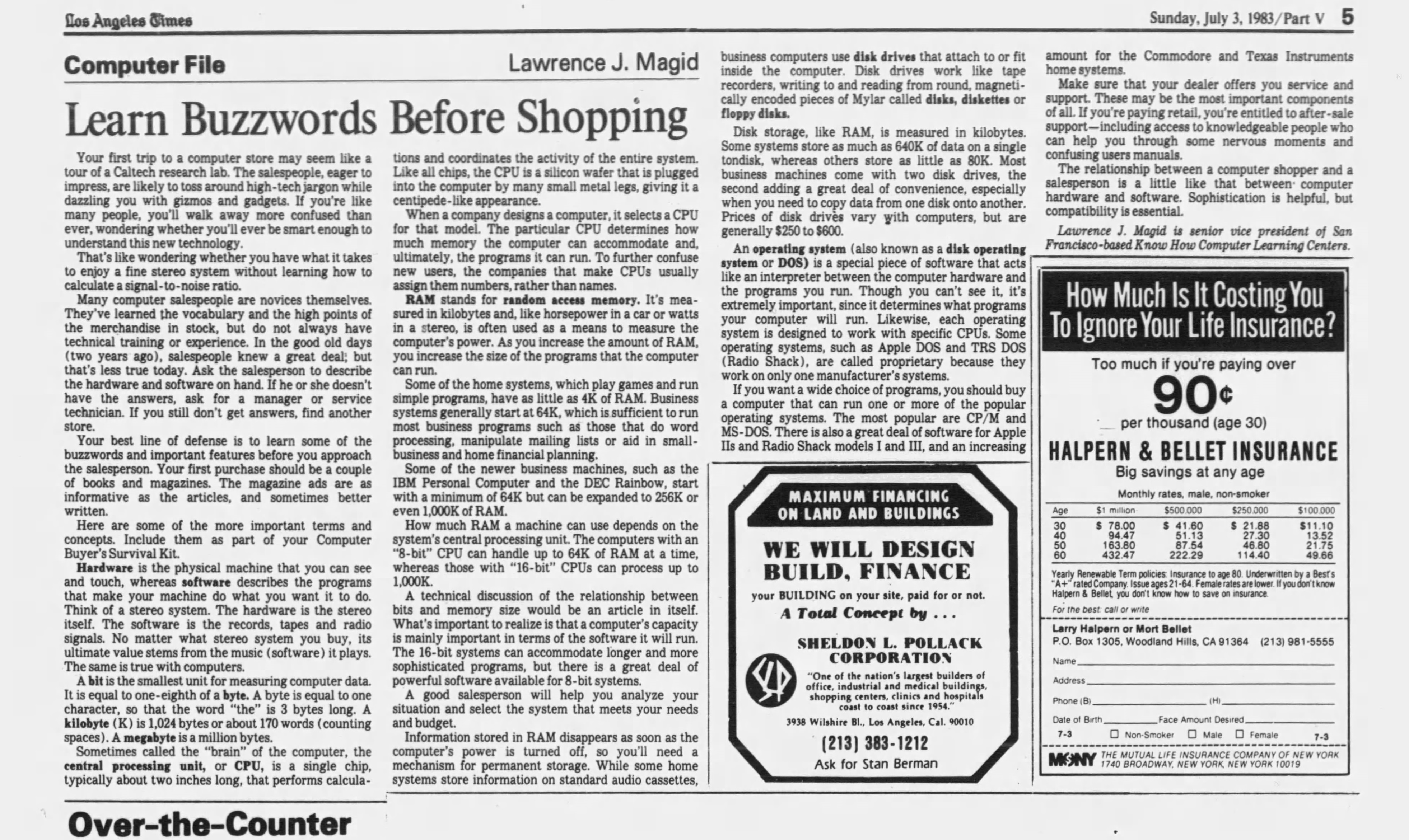by Larry Magid
 That first 1983 column, “Learn Buzzwords Before Shopping,” described what were, at the time, unfamiliar terms like computer hardware, software, floppy disc, bite, kilobyte and megabyte. After defining what RAM (random access memory) stood for, I pointed out that computers could have as little as 4K of RAM and 80K of storage. My current PC’s 1-terabyte drive holds 13 million times more data than an 80K diskette. An Apple Watch has 400,000 times as much storage.
That first 1983 column, “Learn Buzzwords Before Shopping,” described what were, at the time, unfamiliar terms like computer hardware, software, floppy disc, bite, kilobyte and megabyte. After defining what RAM (random access memory) stood for, I pointed out that computers could have as little as 4K of RAM and 80K of storage. My current PC’s 1-terabyte drive holds 13 million times more data than an 80K diskette. An Apple Watch has 400,000 times as much storage.
A December 1983 column, “Yes Programs Do Windows” quoted then Microsoft chairman Bill Gates teasing what would eventually become Microsoft Windows, which “makes provisions for users to view two or more applications at the same time.” Windows 1.0 was released two years later.
In January 1984, I wrote about the new Apple Macintosh after meeting with “Apple’s young chairman, Steve Jobs.” I declared that “I rarely get excited over a new computer. But Apple’s Macintosh, officially introduced last Tuesday, has started a fever in Silicon Valley that’s hard not to catch.”
Over the years, I wrote a lot about online communications with columns about Compuserve, The Source, Prodigy and AOL. I was incredibly impressed that these services let you read out-of-town newspapers, sometimes before they were published in print. And I loved being able to send email, albeit only to other subscribers of that same service. In 1987, I wrote glowingly about MCI Mail which allowed me to send messages through the phone network without having to make a long distance call. Each email cost about 50 cents, and you could only exchange messages with other MCI Mail subscribers.
In one 1983 column, Users Have Head Start on the Future, I wrote that “Futurists have long predicted that citizens will someday routinely use home computers for such tasks as shopping, banking, making travel plans, checking the news and paying bills,” adding, “Microcomputer users have a head start on the future.”
In August 1983, I wrote about the advantages of using a computer to write vs. a typewriter with advice on how to get a good PC-based word processing system. For output, most people needed to chose between a letter-quality daisy wheel printer or a dot matrix. The most powerful word processing program at the time was WordStar which, for $495 ($1,539 in 2023 dollars) made it possible to do things like “insert, delete, move text and search for words and phrases,” along with other more advanced features.
It wasn’t until 1993 when I started writing about the internet, which I described as “a global network of networks,” accessible on university campuses as well as employees of many companies and government agencies,” with “between 15 million and 20 million users worldwide.” Today there are more than five billion internet users, according to Stastica.
New Buzzwords
I’m tempted to write a new version of that “buzzwords” column. The new version would include Generative AI, Metaverse, Web 3.0, augmented reality, quantum computing, cloud computing, big data, big tech, extended reality (XR), blockchain, chatbots, crypto, Internet of Things (IoT), machine learning, natural language model and much more.
Speaking of changing but staying the same, one buzzword I might bring back is “time share.” It’s a pre-PC era term that once referred to using computer terminals to access centralized mainframe computers. Those desktop terminals are mostly gone, but in some ways smartphones, tablets and PCs are functioning like terminals, linking your device to a giant centralized computers or banks or servers that power the internet.
If some of today’s buzzwords are unfamiliar to you, don’t despair. Words that are now common knowledge were obscure back in 1983. One difference is that we now have access to the internet, which makes it easy to define those words.